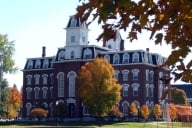You have /5 articles left.
Sign up for a free account or log in.

Betty Ishoy, a faculty member, talks to nursing students at West Georgia.
University of West Georgia
Don’t mention the “R” word to Kathryn Grams.
The dean of the School of Nursing at the University of West Georgia is a baby boomer who became a nurse educator more than 20 years ago. Unfortunately, so did most of her colleagues.
That means an entire cohort of nursing faculty will be retiring at roughly the same time, leaving vacancies that will be burdensome to fill.
“Nursing education is in crisis,” Grams said. “And I think the problem is pretty invisible until you line us all up, and you see how much older we are all than our faculty in other departments.”
The faculty shortage crisis is certainly clear for nurse educators, particularly at an institution such as Cuyahoga Community College in Ohio. Its nursing program has been in danger of losing its accreditation since 2010, because too few of its part-time faculty members have master’s degrees in nursing.
The Accreditation Commission for Education in Nursing (formerly the National League for Nursing Accrediting Commission) dropped Tri-C’s nursing program from “full accreditation” to “accreditation with conditions,” and then entirely revoked the program’s accreditation. It was reinstated after Tri-C filed an appeal, and the community college is waiting for a hearing in August to find out its status. The ACEN standard says that within an associate degree nursing program, a minimum of 50 percent of the part-time faculty must hold a graduate degree. Whether a board of nursing will license an individual who has graduated from an unaccredited institution varies depending on the state. Each state has specific criteria for what is necessary to become licensed in that state, said Dawn Kappel, Director of Marketing and Communications at the National Council of State Boards of Nursing. (Note: This paragraph has been updated from an earlier version that said a state board "will not" license a graduate from an unaccredited institution).
“The demand for nurse educators in the Northeast Ohio region will increase by 11 percent between 2010 and 2015,” the college wrote in an e-mailed statement. “Competing for that limited pool of credentialed nursing educators is a challenge for most community colleges, who are working to keep tuition at affordable levels.”
At the time Tri-C sent its follow-up report to the accreditation commission in 2012, 32 percent of part-time faculty had MSNs, said Tri-C spokesman Alan Moran in an e-mail. After sending out more than 3,000 recruitment letters and holding a series of job fairs, the college has hired more MSN credentialed part-time faculty members. 67 percent of part-time nursing faculty will hold advanced degrees in fall 2013, Moran said.
Marywood University in Pennsylvania is facing similar woes. Its nursing program’s accreditation was also revoked, but it too filed an appeal and now remains accredited with conditions. Students filed a lawsuit in June claiming that the university failed to disclose the accreditation status of the program. The lawsuit states that the nursing program's accreditation was originally revoked in part because the number of full-time faculty members holding a doctorate did not meet the 25 percent minimum the ACEN requires. However, Juneann Greco, a spokeswoman for the university, said in an e-mail that this was one item cited in the appeal, because the reference was to two part-time clinical faculty members (as opposed to full-time faculty) and they were employed prior to the time that the ACEN raised the standard. She said she was not able to comment further on the other issues raised in the ACEN's accreditation review.
For institutions that are not feeling the immediate effects of nursing faculty shortages, the inevitable, looming retirements are a real fear.
The average age of a doctorally prepared professor of nursing was 60.5 in 2010, says a report administered by the American Association of Colleges of Nursing. And historically it has been difficult for universities and colleges to recruit new nursing faculty who have master’s or doctoral degrees. In 2012, 8 percent of full-time nursing faculty positions and 7 percent of part-time positions were vacant, according to an AACN survey of nursing programs at 662 institutions around the country. Universities and community colleges have a hard time competing with hospitals, corporations and the military, who can all offer nurses with advanced degrees much higher salaries, said Polly Bednash, who is the executive director of the American Association of Colleges of Nursing.
“There is intense competition,” Bednash said.
Grams said the University of West Georgia conducted six national and international searches to find nurses with doctoral degrees last year. How many candidates applied? One or two, she said.
And nurses who do not have doctoral degrees do not have much incentive to return to school.
“When a nurse practitioner comes to me and says she has a master’s degree and is making $125,000 per year, I tell her ‘You’d have to go back to school for more years, and I’m only going to pay you half of that.’ People say, ‘Why would I do that?’ ”
While the pay cut that comes with choosing an academic as opposed to a clinical career “is nothing new,” Grams said graduates of nursing programs have many more options now, and “the young folks aren’t coming along” to teach like they used to.
Her generation is leaving the nursing education field at a time when nursing services are expected to be in the highest demand. When the Affordable Health Care Act is fully in place, more than 30 million newly insured citizens will need care, Bednash said. The act also calls for new health care delivery models, which means nurses will be crucial providers in nurse-managed health centers, accountable care organizations, community health centers, and minute clinics, Bednash said.
This may be good news for prospective nursing students, but not if there are not enough professors to teach them.
U.S. nursing schools turned away 75,587 qualified applicants to baccalaureate and graduate nursing programs in 2011 due to an insufficient number of faculty, clinical sites, clinical preceptors and budget constraints, according to the Association of Colleges of Nursing.
And even the top-ranked nursing schools in the country need to recruit aggressively to find qualified faculty. Johns Hopkins School of Nursing recently boasted of its addition of seven new faculty members, but recruiting takes real strategy admitted the school’s dean, Martha N. Hill.
“It’s all about what kind of a package can you put together, and what can of recruitment can you do that excites them,” Hill said. “And sometimes we have to be creative and introduce the notion of coming to Hopkins to people who weren’t actively, or even passively, looking.”
Of course, Johns Hopkins has more money to help the issue than a local community college.
“We watch the data on salaries and we pay attention to. I think we stay pretty competitive,” Hill said.
The mean salary for full-time nursing professors is $102,399, according to AACN data for the 2012-2013 academic school year. The 25th percentile is $82,005 and the 75th percentile is $117,075. The maximum salary, according to the AACN data, is $272,095.
Johns Hopkins School of Nursing ranks in the 75th percentilereally only 75th? I would have thought toward the top -- and does this study say anything about midpoint or high /low so we can have perspective? -sj in terms of faculty salaries when compared to its peer programs, said Jennifer Calhoun, the assistant dean for strategic initiatives and integration at the School of Nursing. The school also helps with relocation expenses for its new hires, Calhoun said.
The major shortage that Johns Hopkins nursing programs faces, along with many other programs across the country, is in nurse preceptors.
“It is a challenge because of the stressors on the clinical sites themselves, the changes now in the economic environment,” Hill said. “Hospitals are having large layoffs, and it makes the demands on the nursing staff even greater. And that affects their capacity to take students who require one-on-one precepting.”
Creative Solutions
It’s not all gloom and doom for nursing schools. Programs at four-year institutions as well as community colleges are coming up with creative solutions to hire and retain new faculty.
At the University of West Georgia there has been reason to celebrate. Thanks to a $503,020 award through the two-year University System of Georgia’s (USG) Nursing Faculty Initiative, the university was able to support students and increase enrollment in its brand new online doctoral program — an Ed.D. degree in nursing education.
Georgia Governor Nathan Deal and the Georgia General Assembly created the USG Nursing Faculty Initiative, and invited all 31 public institutions within the state’s university systems to submit proposals of how they would use the money to improve the development, recruitment and retention of nursing faculty.
At West Georgia, the funding helped attract applicants to the program, because it allows any faculty member who is teaching full-time at one of West Georgia’s sister institutions to teach part-time and still receive a full salary. Additionally, tuition is free for any faculty member at West Georgia or a sister institution who enrolls in the Ed.D. online program.
It gives an incentive for nursing faculty to earn their doctorate while learning how to teach effectively, and with luck they will stay and teach in the university system, Grams said.
In 2009, the Robert Wood Johnson Foundation and the New Jersey Chamber of Commerce Foundation launched an initiative in anticipation of severe nursing faculty shortages in New Jersey.
The New Jersey Nursing Initiative provided scholarships and stipends to 61 scholars from nine universities across the state in order to help them earn advanced degrees. In addition to completing a nurse practitioner program, the scholarship recipients were “developed into the faculty role,” said Sue Salmond, who is one of the initiative’s co-directors and dean of the Rutgers School of Nursing.
“What it is able to do is provide an immediate pool of faculty for New Jersey nursing programs,” Salmond said. “[The scholarship recipients] have gone into either full-time teaching or are taking positions as nurse practitioners, but are doing part-time teaching with many of them planning to go to full-time teaching.”
Instead of providing scholarships, Lorain County Community College in Ohio has been telling nursing instructors since 2009 that they have five years to earn a master’s degree or they’ll lose their jobs. Nursing faculty can also take some of that coursework at the school tuition-free. Another step some universities are taking to address the faculty shortage is for clinical agencies and hospitals to “share” graduate-prepared nurses who are interested in teaching, said AACN’s Bednash. Through those arrangements, hospitals might provide salary offsets for faculty who are teaching in partnering schools or offer release time to those educators.
The University of West Georgia is taking one more approach: Get them while they’re still young.
The nursing school has created a “nursing scholars” program in which high-achieving freshmen are targeted early and invited to work closely with faculty in order to learn about the advantages of becoming a nurse educator.
“We’re willing to target our young students to get them into faculty positions before they’re 35 or 40,” Grams said. “We need them there on campus when they’re 30, not 50. Just think just how many more years of productivity they can provide.”








